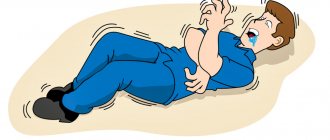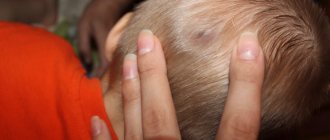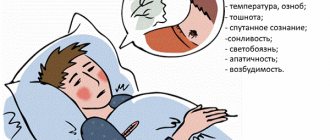It is a known fact that cockroaches are likely to outlive humans, since they can withstand 2 thousand times more radiation levels than us, and also go for several days without food. But this does not console people who suffer from the fear of these insects. The name given to this disorder is blattophobia (from the Latin blattella - cockroach, fobos - fear).
A persistent and unfounded fear of the Prussians can turn the sufferer's life into a nightmare.
Many people feel uncomfortable or afraid of the presence of insects. They are known to live in dark and warm places that are abundant in food. Often at night or in the absence of light, they crawl chaotically around the room and can end up on the human body. This can cause deep fear or disgust, as it is an evolutionary reaction. Our prehistoric ancestors were programmed to be on alert for insects while they slept in caves.
The person may have had negative or traumatic experiences with cockroaches in the past. Children could be punished or locked in closets, in dark rooms where such creatures hide. Fearful adults may unknowingly pass on their fear to children watching them.
Most episodes from childhood resolve over time. However, in some cases, reactions may persist into adulthood.
Overcoming the fear of cockroaches
There are more than 900,000 known species of insects on earth, but the most resilient of these creatures of nature is the cockroach. Many millions of years ago, a small insect appeared that survived the era of dinosaurs, the Ice Age and still lives side by side with humans, causing great inconvenience both in everyday life and psychologically. There are people who are terrified of these “creatures.” What is the name of the phobia, is it possible to fight it alone?
Blattophobia - fear of cockroaches
conclusions
Blattophobia is a type of zoophobia and is a pathological fear of cockroaches. The phobia may be based on a childhood experience associated with an insect, or an inadequate reaction of a significant adult to its appearance. You can cope with fear on your own, however, in serious cases it is very difficult. Therefore, it is better to consult a psychologist or doctor who will help you understand the reasons and choose the best treatment methods.
Meeting a cockroach at home or in a cafe will cause a lot of negativity in any person. But there are people who are not just disgusted by cockroaches, but who are frightened by the mere thought of these insects. What is the fear of cockroaches called, why does it arise, and how to get rid of fear - psychology will tell you.
Brief description of the phobia
Many of us dream of these nasty insects disappearing from the face of the Earth. They are associated with unsanitary conditions and infections. But there is a category of people for whom these insects cause not just disgust, but panic fear. They understand that their excessive worry is unfounded, but they cannot do anything about it.
Fear of cockroaches is a phobia that greatly interferes with a person’s life. Officially it is called blattophobia.
According to research by the International University of Psychology in Berlin, every tenth inhabitant of the planet suffers from this phobia, and this fear comes from childhood. In most cases, it occurs as a result of psychological trauma.
The cause of injury can be various factors. In childhood, ideas about the beautiful and the terrible are formed in our subconscious, and cockroaches clearly do not fall into the first category. Children's consciousness is influenced by the example of parents who mercilessly hit a small insect with a slipper and scream heart-rendingly. Cinema also strengthens this idea by making horror films in which the red cockroach plays the “main roles”.
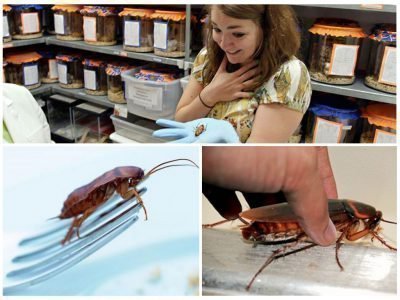
Women are more likely to be afraid of cockroaches
Also, people with increased nervous excitability, when faced with cockroaches, experience an enormous stressful situation, which in the future can provoke the appearance of a phobia of cockroaches. Women are at risk. The fact is that tactile sensations are important for women, and bodily contact with a dangerous insect causes them a feeling of disgust, which can degenerate into an obsessive fear of cockroaches.
They are incredibly fertile
As we said earlier, these individuals are unusually prolific and are not so easy to get rid of. Thus, a pair of German cockroaches, breeding in conditions of accessible and plentiful food, in a few years can increase their numbers to three million creatures. They eat everything they come across and are able to exist in any conditions. However, none of these features shed light on the cause of human panic.
It turns out that this phobia begins in childhood, around the age of four or five years. And this fear is formed by the reaction of parents. Therefore, if you do not want to instill absolute horror in your child’s mind, do not scream at the top of your voice the next time you find a cockroach in the apartment.
Blatophobia is one of the few rare human phobias, which is translated from Latin as “fear of cockroaches.”
Cockroaches, like many insects, are long-lived in our habitat and have maintained their existence since ancient times. By scientific standards, today scientists count about 3,000 species of cockroaches, but many more species remain unknown and their discovery occurs regularly.
Blattophobia occurs for the same reasons as many phobias, namely as a result of psychological trauma in childhood. Everyone has long known that phobias do not arise on their own, and the cause of psychological trauma can be various factors, as well as unpleasant incidents. An example would be various horror films featuring infestations of giant cockroaches. A child, seeing this, can form a fear of these insects in his head and transfer his fear to real life. Another example would be if a child saw an adult’s inadequate reaction towards a cockroach (for example, screaming, fear).
A person who has this phobia at a moment of panic realizes that his fear is not at all justified, but there is nothing he can do about it. Accompanied by panic, a person begins to experience nausea, sweating, loss of orientation in space, and in some cases, loss of consciousness.
At the first sign of panic in a person suffering from this phobia (or even other phobias), he needs to be calmed down and brought to consciousness, put a cloth moistened with cool water on his head and given whatever, be it a soothing decoction or tablets.
At first glance, this phobia is not dangerous, but in rare severe cases, it can cost your life. This is due to the fact that in severe cases a person is not responsible for his actions and may grab any object and injure himself (for example, a knife), and may also experience paralysis of the entire body. Such cases are very rare, but if a child develops blattophobia, you should immediately consult a doctor in order to prevent this phobia at an early stage.
Symptoms of the disease
The most common symptoms are the following; they can appear individually or as a group:
- inappropriate actions and behavior (squealing, waving arms, etc.);
- an irresistible desire to avoid contact with insects;
- asthma attacks, heart attacks;
- uncontrollable sobs, hysterics (the person understands the absurdity of his behavior);
- lightheadedness or fainting;
- trembling in the body;
- nausea, sweating;
- throat spasm;
- stupor;
- panic.

Panic is a common occurrence when you see a cockroach.
How to get rid of fear
At an early stage, you can cope with fear on your own. For moderate phobias, it is better to consult a doctor; in severe cases, medication may be needed. But first things first.
Help from a psychologist
For professional treatment, one of the following methods can be chosen:
- Hypnosis. The psychologist puts the client into a trance and reprograms the consciousness, changing the negative attitude to a healthy attitude towards cockroaches. This method is suitable for suggestible people without secondary mental disorders and at a mild stage of phobia.
- Virtual approach to the object of fear. Using a virtual reality helmet, the client is immersed in the world of cockroaches, the psychologist helps to control the condition and reminds them that these are virtual insects. This method can only be used under the supervision of a psychologist, at a mild stage of the disorder. At an advanced stage, such therapy will cause shock, severe fear and a panic attack.
- Cognitive behavioral therapy. The client and psychologist make a list of frightening situations. After this, they are played one by one. For example, first the patient looks at a photo of cockroaches, then a video, then at live insects behind glass, etc. At each stage, the specialist reminds about methods of self-control and new (pre-developed) response models.
- Neurolinguistic programming. During the sessions, the client realizes the irrationality of his perception, and together with the specialist he creates a new picture of reality.
Art therapy and fairy tale therapy are used to treat children. You can come up with a fairy tale yourself. It is important that the cockroach is described there in a positive way. But within the framework of art therapy, you can depict how a child overcomes his fear, defeats an evil cockroach. When working with school-age children, you can study the encyclopedia, get acquainted with the characteristics of individual insects, and approach fear with the help of illustrations. And, of course, parents should control their reactions and not react by screaming at cockroaches.
It is important! The treatment method is selected individually depending on the client’s characteristics and medical history. Sometimes a combination of several psychotherapy methods is used.
Methods for correcting the condition
As an additional treatment for rapid correction of the condition in case of severe anxiety, sleep problems, hallucinations and panic attacks, the psychotherapist prescribes antidepressants, beta blockers, tranquilizers, and psycholeptics.
Getting rid of the fear of cockroaches on your own
As part of self-help, you can use auto-training. First you need to relax your body and brain, take a comfortable position, turn on soothing music or retire in silence and repeat the installation for self-hypnosis: “I conquer my fear”, “I created my fear myself, now I myself let it go”, “I am not afraid of cockroaches” "
It is recommended to consider auto-training as an auxiliary means of self-medication. The main method is a gradual approach to the object of fear. Only by overcoming yourself and looking fear in the eyes can you get rid of a phobia. Conduct auto-training, and then look fear in the eyes. If you feel bad, repeat affirmations and breathe deeply. You can invite a person who does not have blattophobia to visit, and together with him look your fear in the face.
This is interesting! In some countries, certain types of cockroaches are considered a delicacy. Why don't you literally bite the head off your fear?
Fear of cockroaches is very common, and this is understandable: these insects have an unsightly appearance and live in human homes. But if the designated phenomenon turns into a pathological one, something needs to be done about it, because what arises can end in a completely incomprehensible way. In medical circles, fear of cockroaches is called blattophobia.
Methods for dealing with phobias
Taking your fear of cockroaches for granted is not a solution to the problem, but a self-defeating escape attempt. Fear destroys a person's life, and it takes a lot of effort to become the master of your fear, and not remain a prisoner. Accept the problem, understand it and start fighting using an integrated approach. Cockroach phobia can be treated using psychotherapy or medication.
Drug treatment
Medicines are prescribed exclusively by a doctor. Self-treatment can lead to serious consequences.
The list of medications below is for informational purposes only.
- Tricyclic antidepressants (Fluoxetine, Sertraline).
- Weak tranquilizers (Phenazepam, Imipramine). They must be used directly during panic attacks.
- Tablets that block the feeling of increased anxiety during an encounter with an insect. These include Buspirone.
But medications can only help temporarily, directly during a panic attack, when the patient needs to be calmed down by giving a soothing decoction or pills.

Medicines must be taken as prescribed
Other methods to get rid of the problem
The main assistance in the fight against blattophobia can be provided by qualified psychotherapists or psychiatrists. They will teach you how not to succumb to phobias and reduce the negative impact of stress on the body. Treatment for each individual is selected individually, as it depends on many factors.
- Hypnosis is a state in which suggestibility increases and the absence of fear of a phobia is imprinted in the subconscious. Not all patients will agree to this method of treatment, all because of the same fear, but all phobias can be treated with hypnosis. The doctor puts the patient into a trance and, asking him leading questions, determines the true cause of fear.

Hypnosis against phobias
- The method of autogenic training consists in mastering the technique of self-hypnosis, in which a feeling of heaviness arises in the body, as a result of which a state of muscle relaxation is achieved, the so-called. relaxation. To do this, you need to turn on calm music, relax, even out your breathing, turn off your emotions, close your eyes and start saying self-hypnosis phrases: “I am brave.” I easily overcome my fear”, “I know that my fear is created by me, which means I can overcome it”, “I turn off my fear of (cockroaches) for the whole day.”
- The practice of yoga is a good helper in the fight against phobias. Regular yoga classes provide an outlet for our fears, gradually eliminating the level of anxiety.
- One of the effective techniques in struggle is to face your fear. By overcoming yourself, you will overcome your phobia. The exit should not be rapid, but gradual.
- Playing sports in the fresh air is a cure for many diseases, including blattophobia.
Ways to deal with the fear of cockroaches
Fear of cockroaches is a very complex disease because it is difficult to correct. Treatment of blattophobia may take a short period of time if you approach this issue with all responsibility.
Drug treatment of blattophobia
For mental pathologies of any nature, one cannot do without the use of medications. Therapy to get rid of blattophobia usually consists of using the following miracle pills:
- Antidepressants of the tricyclic group
. When taken, certain substances in the human body are activated, which in medicine are called neurotransmitters. For blattophobia, the psychotherapist usually prescribes Sertraline, Moclobemide or Fluoxetine to his patient. - Benzodiazepines
. These developments in medicine are considered weak tranquilizers. When a panic attack begins, these medications should be taken. Phenazepam, Imipramine or Alprazolam have proven themselves to be excellent in the treatment of blattophobia. - Beta blockers
. They are primarily used to treat cardiovascular diseases. However, panic attacks deal a crushing blow precisely to this area of the human body. Therefore, they are simply necessary in the complex treatment of blattophobia. - Psycholeptic drugs
. The use of the indicated drug therapy is necessary to relieve increased anxiety when seeing cockroaches. Buspirone is one of the best medicines when it comes to fear of insects.
Help from a psychotherapist in dealing with blattophobia
Any specialist will immediately tell his patient that taking medication alone is definitely not enough. Tranquilizers and antidepressants will only help relieve tension temporarily if you do not undergo the following therapy:
- The “virtual cockroaches” method
. With this method of combating blattophobia, a situation is created in which the patient finds himself alone with the subject of his fears, while being completely safe. A helmet equipped with displays and video cameras is placed on the patient’s head. Consequently, a person who is afraid of cockroaches is simply surrounded on all sides by these insects, which are just virtual objects. - Hypnosis therapy
. For any phobia, the therapist will advise the affected party to release their “inner beast.” This occurs best when the patient is in a trance state. In the future, only the blattophobe will decide about the advisability of the announced event, because most people are simply afraid of it. - Neuro-linguistic programming
. This method allows us to understand the model of reality that a person has created for himself. During NLP sessions, the so-called “reprogramming” of consciousness occurs and the creation of a new attitude to the surrounding reality. - Cognitive therapy
. During practical classes, so-called situation modeling is performed. After finding out the cause of the problem, the patient begins to learn how to control the unpleasant and frightening events in his life.
How to get rid of blattophobia - watch the video: If a blattophobe does not know how to overcome the fear of cockroaches, then he should listen to the advice voiced in the article. In severe forms of this pathology, everything can end in convulsions and even paralysis.
Alternative medicine for treating insect fear
As a sedative for neurasthenic conditions, tincture of peony, motherwort, and hawthorn is used, 25-35 drops 3 times a day, the course of treatment is a month. For general calming of the nervous system, take fresh motherwort herb juice 30-40 drops 3-4 times a day 30 minutes before meals. For neurasthenic conditions, you can also use the following decoction: pour 1 tablespoon of peppermint leaf into 1.5 cups of hot water, cook for 15 minutes over low heat, take 0.5 cup three times a day.
The main thing is to promptly recognize the presence of a problem, do not delay treatment and visit a specialist who will definitely be able to help you overcome your fears.
It's all about biology
Psychologists say that the things we find so repulsive about cockroaches lie in their biology. This aversion to fatty, smelly and slimy creatures is passed down from generation to generation. We are terrified by their unpredictable movements and phenomenal speed. If you compare their size and speed of movement, cockroaches are considered one of the fastest land creatures. Their unpleasant odor is also biologically explainable: cockroaches store uric acid in their bodies, which helps process food. And finally, their unpleasant appearance and glossiness are achieved thanks to secreting waxy lipids, which save cockroaches from loss of moisture. Purely visually, none of the listed features evoke positive emotions.
Reasons for fear of cockroaches
As a useful mechanism for protecting ancient people from danger, the fear of insects has long been unfounded. But fear of cockroaches does not arise out of nowhere. After all, everything has its own root causes. It is better to look for them in childhood or remember other stressful situations.
An irrational fear of cockroaches arises against the background of:
- Stereotypes of others . A mother panicking at the sight of an insect passes on her fear to her baby. And if a child has repeatedly observed an overly emotional reaction, then he inevitably begins to fear household pests.
- Excessive disgust . If a person experiences a strong aversion to everything dirty, then the cockroach, as a carrier of infection, will cause negative emotions. In people with a weak psyche, this quickly develops into a phobia.
- Stressful situation . Cockroaches are ubiquitous sneaks. You can hear stories from doctors when a cockroach climbed into a sleeping person’s ear or nose. This is a rather painful condition, and having to go to the hospital for such a problem causes a feeling of great shame. After removing the parasite from the body, fear of cockroaches becomes a natural reaction of the patient.
Often the disease is diagnosed in people who have experienced severe hardships or natural disasters. After all, the need to live in conditions of domestic troubles causes serious stress when you constantly see parasitic insects.
Store-bought cockroach repellents
Modern insecticides are low cost, have a low degree of toxicity and do not require special skills and knowledge to use. By following the instructions supplied by the manufacturer, every person can use the product without harm to health, implementing effective measures to prevent or eliminate cockroaches in their own apartment. Regardless of the form of release and the principle of action of the drug, all insecticides can be divided into the following groups regarding composition:
- Organophosphorus compounds (OPCs) are strong, broad-spectrum poisons that have a nerve-paralytic effect. They are rarely used for treating residential premises, as they take a long time to erode and pose a significant danger to all warm-blooded creatures. This group includes the following substances: chlorpyrifos;
- malathion;
- fenthion;
pyrethroids are neurotoxic poisons that effectively kill cockroaches and are relatively safe for humans. Their disadvantage is that they quickly disintegrate under the influence of light, however, thanks to modern forms of release, manufacturers have managed to increase the duration of action of poisons. This group includes the following active components:
- deltamethrin;
lambda-cyhalothrin; cypermethrin; fenvalerate; zeta-cypermethrin; malathion
According to the form of release, insecticides can be divided into:
- gels are poisons that are highly toxic to cockroaches; most often they have a pleasant smell and taste for insects. They act by contact and intestinal route, prominent representatives of the group are: “Kapkan Sturm” (gel paste), “Fas” gels, Global;
- aerosols are potent poisons that, due to their shape, can penetrate small cracks and under baseboards, destroying parasites that hide there. Among the most popular aerosols against cockroaches are Combat and Raptor;
- powders are loose mixtures that have a lethal effect on insects by contact. The disadvantage of this form is that the powder can enter the respiratory tract, presenting a danger to humans and pets. To combat parasitic insects, you can purchase Pyrethrum or Frontline M powder;
- Liquid poisons are the most powerful preparations used by professional exterminators when treating premises. These products can be divided into two groups: liquid concentrates - powerful pesticides that can completely destroy cockroaches indoors, have a pronounced unpleasant odor, are highly toxic to humans, and require special protective equipment during processing. The most effective concentrates are considered to be: “Tsifoks”, “Avalon”, “Executioner”;
- microencapsulated - the latest drugs in the form of microscopic capsules that contain poisons. These products are considered safe for people and animals and last for several weeks. The product can be purchased under the following names: GET Total, “Delta Zone”, “Xulat Micro”;
aquafumigators are devices containing poisons that are activated when water is added. The fumigator evaporates the active substance in the form of steam, which penetrates into all crevices, destroying insects. Its disadvantage is that it is highly dangerous for humans; when processing the premises, it is necessary to leave the apartment. The most effective aquafumigators are products from the Reid, Raptor, and Off brands.
Photo gallery: industrial preparations for cockroaches

The disappearance of insects begins within a few hours after contact with Global gel

Combat spray has an effect only on adult individuals, but the product is practically powerless against larvae and laid eggs.

"Frontline M" causes contact-intestinal disorder in cockroaches, leading to instant death

"Tsifoks" is an effective, fast-acting universal drug

The Raptor aquafumigator is very simple and safe to use
Manifestations of fear of cockroaches in humans
Regardless of the cause of the disease, the symptoms for all people with blattophobia are approximately the same. If there is an excessive reaction specifically to cockroaches, but snakes, spiders or other animals do not cause panic, you can safely diagnose a phobia.
At the sight of one tiny insect, the patient experiences sudden, severe panic. The body reacts to this:
- uncontrolled tremors of the limbs;
- profuse sweating;
- dry mouth and ringing in the ears;
- suffocation and heart rhythm failure;
- dizziness and loss of consciousness.
With a particularly advanced and serious disorder, a person may experience fear of death when seeing a picture of a cockroach, for example on TV. He doesn't know how to stop being afraid of cockroaches or images of them.
Natural enemies of cockroaches
Cockroaches have many enemies, ranging from predatory insects to large primates. The most exotic hunter of these pests is the emerald wasp. She hunts cockroaches and, having found an insect, injects poison into it with a sting, which has a neurotoxic effect. After being bitten, the cockroach loses control of itself and loses the ability to move. The wasp takes the prey to its burrow, where it is eaten by the larvae. In addition to wasps, a large number of animals feed on cockroaches:
- arachnids;
- monkey;
- hedgehogs;
- shrews;
- birds;
- rodents;
- other insects.
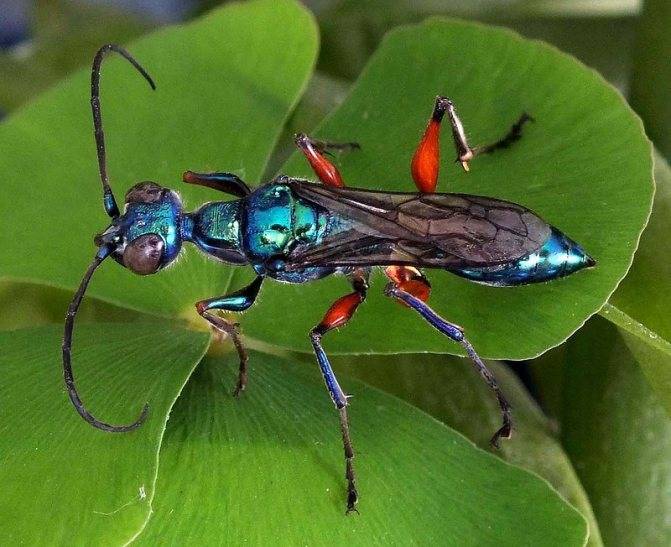
The emerald wasp preys on cockroaches, the size of which can greatly exceed the size of the wasp itself.
The danger of blattophobia
Blattophobia is not nearly as harmless as it might seem at first glance. A large-scale attack causes serious surges in blood pressure and a powerful surge of adrenaline. In some cases, this can lead to paralysis and death.
In everyday life, people with a fear of cockroaches behave irrationally in any situation, which causes serious inconvenience to others. Blattophobes constantly wash their hands and clean surfaces without apparent need. An exterminator periodically appears in the patient's home and carries out preventive measures where this has long been no longer necessary. As a result, a large amount of personal time, effort and money is spent fighting non-existent beetles. They often do not eat in public or visit friends. The patient believes that there are cockroaches in any territory not under his control.
Where do cockroaches come from in an apartment?
Cockroaches are a common problem, which is not always a sign that the owner of the home where they appeared is a slob. There are a huge number of options for insects to enter your home. First of all, they look for rooms protected from the cold, where they can hide and find food and water. Insects can enter residential apartments and houses in the following ways:
- through the ventilation system from neighbors or from the garbage chute - this happens if the population of cockroaches has grown significantly and they are in search of new territories to live. This is also possible if neighbors carry out disinfestation measures;
- through cracks in the building, keyholes, open windows and doors - when it starts to get cold outside, cockroaches quickly begin to look for shelter, as they can hardly tolerate temperatures below 15°C;
- from stores in grocery bags - cockroaches are very fast and tenacious; the female of this parasite can hide behind product packaging or hide under fruits and vegetables. By placing purchased goods in a bag, you may not notice a small brown cockroach, which can subsequently lay eggs and independently increase the population.
Serious form of disorder
If you can’t cope with the problem on your own, psychotherapy will be the only reasonable way out of the situation. An experienced psychologist uses the following treatment methods:
- hypnotherapy or programming of human consciousness. During a hypnosis session, work with the subconscious occurs, aimed at completely getting rid of fear;
- neuro-linguistic therapy. In collaboration with a specialist, the patient realizes the destructiveness of his own reaction and reprograms himself to behave normally when he sees a cockroach;
- cognitive therapy. During sessions, an experienced doctor exposes the patient to indirect exposure to insects and teaches them to cope with fear independently.
At the end of treatment, any of the patients can be completely calm near the cockroach and live a full life as a healthy person.
How to treat?
To get rid of blattophobia you need to consult a specialist. In this case, a qualified psychotherapist will come to the rescue and select the most suitable treatment option for the patient. There are four most effective methods for combating such fear. The first is hypnotherapy. It makes it possible to program the subconscious, removes fear of insects from memory and ultimately inspires that cockroaches in the house are not a reason to panic. The only catch is that few patients are ready to lose control of themselves and let someone into their subconscious.
Next comes neurolinguistic programming. It is based on NLP sessions, during which a person’s consciousness is switched to another mode and a new attitude is created to the reality around him. Sometimes specialists are forced to resort to the help of modern technology. A virtual reality helmet is best suited for this. It is placed on the patient’s head and he finds himself surrounded by cockroaches, but completely safe. As a result, this should develop a clear association of insects with the absence of even the slightest threat.
And finally, the last technique is cognitive therapy. During its implementation, the psychotherapist begins practical exercises and models certain types of situations. First, the cause of the problem is found out, and then there is a theoretical part, where they teach how to control their emotions and find a way out during frightening events.
Blattophobia: description, symptoms, causes and methods of treating cockroach phobia
Blattophobia is the fear of cockroaches. A phobia of cockroaches prevents a person from living a full life and is a threat to his mental and physical health. It is believed that it is characteristic of women, since they have more sensitive skin and the touch of insects causes a feeling of danger. But this is a debatable issue, since many men are also susceptible to this mental disorder, so we can safely say that cockroach phobia is not distributed by gender.
There are more than 900 thousand different species of insects that live on our planet. Cockroaches survived the era of dinosaurs, the Ice Age and have lived on Earth for more than three hundred million years.
They outlived many representatives of the plant and animal world.
Nowadays, these representatives of insects live side by side with humans, causing a lot of troubles and problems. Blattophobia is the fear of cockroaches, one of the most common phobias, but it should not be confused with the usual disgust that is characteristic of people when they see these pests. After all, when they settle next to a person, they spoil food, leather goods, book bindings, and house plants. This insect can feed on garbage and even feces. For this reason, cockroaches are spreaders of various infectious diseases, such as dysentery, so it is imperative to get rid of them in your homes.
But people who suffer from a phobia of cockroaches are not just disdainful and try to fight these insects, but when they see them, they experience an attack of uncontrollable fear, and the person does not necessarily have to see the cockroach alive. An image of him on a TV screen or in a picture is enough – and panic fear takes over the blattophobe.
How dangerous are these parasites?
Do not think that the only harm from these insects is food spoilage. This is only a small part of the problems that parasites bring with their appearance. After all, cockroaches are dangerous:
- They carry pathogenic microorganisms on their paws that are harmful to human health. After such contact, you can get tuberculosis, hepatitis, and a number of intestinal infections. Therefore, it is recommended to get rid of all products that have come into contact with parasites.
- When molting, they shed the old chitinous shell, particles of which mix with dust and cause an allergic reaction.
- They can crawl into the ear canal at night.
- In some cases, they can bite a person.
- They crawl inside household appliances and damage the insulation, which can cause a short circuit.
Symptoms of the disease

Manifestations of the disease can be different:
- panic attack – when a person sees a cockroach, he begins to panic and go hysterical. He screams, starts running around the room, squeals, and for a long time cannot control his emotions and calm down;
- irrational actions - a person does something that is not typical for him in his normal state. There are times when a blattophobe, in a state of fear, begins to constantly clean, wash and clean the room;
- somatic manifestations - at the sight of an insect, a person begins to have a headache, his heartbeat quickens, he feels pain in the heart area, his hands begin to shake violently.
Clinical signs of fear
A person who has a phobia of cockroaches is not just squeamish about them and tries to get rid of them as quickly as possible. Just the sight of an insect causes real panic in the patient. He stops behaving adequately, his heart begins to beat very quickly, he becomes dizzy, and panic attacks are observed.
Often trembling appears in the hands, and the whole body weakens. A person develops hysterics, he begins to choke and lose consciousness, but this is already in the most severe cases. It is unrealistic to predict such a patient's reaction. He cannot control it, so it greatly interferes with a person’s daily life.
The patient always realizes that his fear of cockroaches has no basis, that it is all meaningless. However, he is unable to overcome his fear. It is not even necessary to see an insect in person for a negative reaction to occur.
Reasons for the development of fear
If you don’t like these insects, feel disgust towards them, and are afraid of them appearing in your home, this is not yet a sign of blattophobia. But if you cannot cope with your feelings, you easily succumb to panic and stress at the sight of a small bug - this is a sure sign that you have developed a phobia of cockroaches. There are many reasons for this:
- Stressful situation. As a rule, it arises and develops in childhood, when the child has experienced fear and negative emotions associated with cockroaches;
- Upbringing. Fear of insects is passed on from parents to children - adults, having a phobia, do not notice how they pass it on to their children, raising them in fear of insects;
- Literary and cinematic works. In books and movies, cockroaches are presented as negative characters and are used to add more poignant moments to the plot - after reading such a work or watching a film, a child begins to dislike and fear insects, associating them with imaginary monsters;
- The unpleasant appearance of insects can also create in a person a feeling of fear towards them;
- Infections. Most often, people are afraid that these insects can be carriers of various diseases, so they do everything possible to prevent them from appearing in their home.
Blattophobic celebrities

Famous people with a fear of cockroaches:
- Peter
I. The Russian Tsar was always distinguished by his firmness of spirit and iron character. Having set himself difficult political tasks, he went headlong towards achieving his goal. However, his extremely negative attitude towards cockroaches was known to all the courtiers. If Peter the Great, while moving around his domain, stopped in any room, then it was carefully checked for the presence of the described insects. One of the subjects decided to play a trick on the king by nailing a cockroach to the wall. Peter I appreciated this kind of humor, giving the merry fellow cuffs and slaps in the face. - Scarlett Johansson
. The actress, who is famous for her acting skills and excellent appearance, is one hundred percent blattophobe. She had never liked these insects before, which caused her an attack of acute rejection. However, after she woke up and felt a cockroach on her face, the actress always falls into outright panic at the sight of the described insect. - Woody Allen
. Four Oscars, however, did not stop him from being a well-known eccentric. He is afraid of literally everything and suffers from a large number of phobias. In addition to being afraid of dogs, the sun, and children's elevators, Woody Allen is very afraid of cockroaches. If his other fears look somewhat ridiculous, then the great master’s blattophobia can be understood. - Nadine Coyle
. The actress and singer from Ireland is afraid of many animals. She is afraid of dogs, cats, snakes and rodents because they can bite her. Nadine hates cockroaches because they are visually disgusting to her. - Johnny Depp
. The fearless hero of many films, known to the general public as Captain Jack Sparrow, once forked out 10 thousand dollars. He literally trashed a luxurious room in a prestigious hotel. Johnny explained his violent and inappropriate behavior by saying that he imagined a huge cockroach in the room, for which he began an active hunt. - Philip Kirkorov
. The “bunny” of the national stage cannot stand air travel, which is inevitable for his career. However, he does not perceive frogs and cockroaches organically. During one of the programs, a toad of considerable size was brought into the studio. Kirkorov's lamentations concerned his admission that he was not afraid of snakes, but it was better for frogs and cockroaches to stay away from him. - Ilya Lagutenko
. The leader of the Mumiy Troll group is horrified by one type of insect being described. After bitter experiences in the past, he also does not like encephalitis ticks. From his demeanor one can conclude that the singer dislikes insects without exception.
Manifestations of blattophobia
People with blattophobia are not just afraid of these insects. They experience very strong, uncontrollable fear. Blattophobia manifests itself in different ways. At the sight of even one insect, a person experiences various psychological disorders:
- Panic attacks. Seeing a cockroach, a person succumbs to fear, panics, and becomes hysterical. Starts screaming, screaming, running around the room or apartment. At the same time, he cannot calm down and pull himself together for a very long time.
- Irrational actions. Under stress, a blattophobe may do something completely out of character and irrational. Sometimes, experiencing fear, a person begins to constantly wash and clean his apartment.
- Somatic manifestations of fear. The person begins to feel unwell. His head hurts, his heart is pounding, he is short of breath, his hands are shaking. These symptoms only appear when cockroaches are seen.
All of the above symptoms greatly complicate life, preventing the blattfob from living a full and normal life.

Prusak can drive a patient into hysterics
Hostility is formed in the mind
Cockroaches are just insects that cannot cause physical harm to humans. But in the human imagination it is not just an insect, it is a psychological barrier that is simply impossible to cross. Otherwise, how can you get all these incidents associated with them out of your head? A string of terrible sensations stretches from a very early age: there is the first impression of childhood, and the feeling of the vile paws of an uninvited guest on the skin, and watching how a whole gang of creatures crawls out from the kitchen table as soon as you turn on the light at night.
What cockroaches scare blattophobes?
People with this phobia are afraid of all cockroaches, but at the same time there are species that inspire them with particular fear.
Firstly, these are red cockroaches, especially loving human homes. They feed on leftover food and multiply very quickly, instilling fear in humans.
Secondly, black cockroaches, which live mainly in basements, so residents of the first floors of apartment buildings suffer from them. These cockroaches differ from the Prussians in their large size, which frightens many people. Thirdly, these are tropical cockroaches - they reach a length of 50–60 cm.

Red Prussians are usually found in kitchens
Deprivation of water and food
Prussians can eat anything, their omnivorousness determines their vitality, but they cannot do without water. You can deprive insects of access to life-giving moisture as follows:
- check the serviceability of plumbing equipment, eliminate leaks;
- remove open sources of liquid;
- wipe sinks, showers, bathtubs dry;
- keep the pipes dry;
- cover the toilet seat with a lid;
- cover drains when not in use;
- ensure that condensation does not accumulate on surfaces;
- remove indoor plants that need regular watering.
All areas adjacent to water sources are treated with insecticides to completely deprive pests of water.
Reduces the attractiveness of an apartment for cockroaches and the inaccessibility of food with a pronounced smell (smoked, spicy, fried), and oily foods. Prussians love to rummage through garbage, so regular cleaning and removal of food waste will help in pest control.






